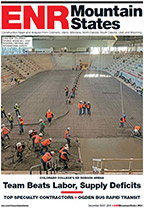On the labor side, unions are expecting good contracts for their members after years of concessions, and many contractors say unions are being reasonable. “Union wages are going up, but the increases are not exorbitant. Unions understand there is pressure on union contractors to be competitive,” says Grau of NECA. He says NECA and the International Brotherhood of Electrical Workers have a joint arbitration-mediation panel to help resolve contract negotiation disputes. “This year, the panel has seen the fewest disputes in 50 years,” Grau says.
Grau notes that the workforce shortage has shrunk the disparity in wages between union and non-union workers, taking away much of owners’ incentives to favor non-union contractors. A recent wage survey showed non-union wages in the crafts increased 6.4% since mid-2014.
Despite the shrinking divide between the costs of union and non-union workers, many union contractors are annoyed about the perceptions among some owners that going non-union will save them money. For example, many of the developer-driven projects in New York City, traditionally a union stronghold, now are going to nonunion firms.
But this trend is not limited to New York. In Washington state, “we are seeing non-union subcontractors on larger tower projects that were predominately handled by union subcontractors in the past. Price has been the driving factor for general contractors making this shift,” says Engle of Long Painting. Rutturo says this trend may not make long-term economic sense. He says developers want non-union contractors, not realizing that the people who will be able to afford to shop in their malls or live in their apartment buildings are middle class. “Union people are America’s middle class.” Developers will defeat their own purpose by trying to go with non-union contractors, he says.
Technology No Longer a Separator
Technology, such as the use of building-information-modeling software, used to be a differentiator. Now, tech know-how is a necessity for subcontractors, and its use is beginning to pay off. “We are finally starting to see where efficiency gains, schedule gains and productivity gains promised by the use of BIM are finally being realized through prefabrication and modular construction. This may be the first real increase in productivity in our industry in several decades,” says Dan Briscoe, vice president, Apollo Mechanical. The growing use of BIM has allowed specialty contractors to develop products that may not have been possible in the pre-BIM days. For example, Finfrock Industries spent the past 10 years developing its DualDeck Building System, which incorporates MEP and fire-protection subsystems into the precast- and prestressed-concrete product during manufacturing. “Computer-aided manufacturing, driven by 3D modeling, ensures dimensional accuracy in the product and exceptional speed during on-site installation,” says Allen Finfrock, CEO.
However, advancing technology does have its price. “It is getting harder to fix mechanical equipment due to [its] complexity. A service technician can no longer go to a jobsite without a laptop. Training is imperative, and the company must shoulder 100% of this training as the trades are unable to keep up with the fast pace of technological advances,” says Reiss of Westside Mechanical Group. Also, some contractors worry that the sheer volume of information and time pressures for quick turnarounds may take its toll. While technology has drastically increased the volume of information available, people still have to understand the project the way they used to “back in the blueprint-sepia- pager-courier days,” says Michael Perle, owner of Perlectric. He worries that trying to keep up with the demands of new technology will create psychological pressures and interfere with employee job satisfaction.







Post a comment to this article
Report Abusive Comment